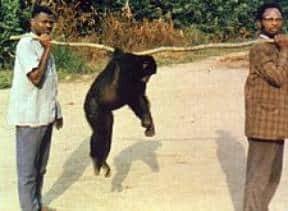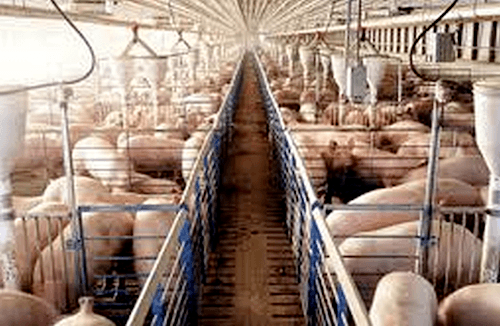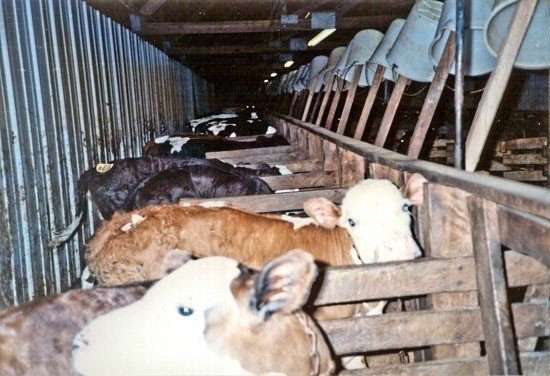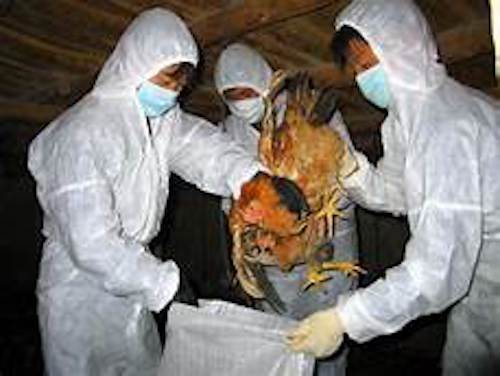Why Influenza and COVID-19 Pandemics Will Not Disappear

Influenza-type COVID-19 has put the world on lock-down, but it was predicted, as are many future influenza pandemics to come, because of how we farm the animals we eat.
Check out my Covid Immunity CourseThere was a time in human history, albeit long ago, that no human got the measles, smallpox, flu or the “common” cold — much less a influenza type coronavirus like COVID-19 — because none of these existed.
Why now?
When did these various types of influenza strains become so prevalent that one of them, COVID-19, has shut down the world economy, will infect millions and kill thousands?
Answer: About 10,000 years ago.
Ten thousand years ago was the first of three major periods of disease since the beginning of human evolution that medical anthropologists have identified. Do you know what else happened then? The domestication of animals.
We’ll begin with the observable:
- When we domesticated cows and sheep, we also domesticated their Rinderpest virus, which turned into human measles. Now pretty much a benign disease, measles killed about 200 million people of the last 150 years.
- It’s likely that domesticated camels give us smallpox.
- Domesticated pigs gave us whooping cough.
- Domesticated chickens gave us influenza.
- Domesticated ducks gave us the flu.
- Domesticated water buffalo gave us leprosy.
- Domesticated horses gave us the common cold.
Let’s explore how all this happened through the penetrating lens of Michael Greger, M.D, who more than a decade ago when he was Public Health Director at the Humane Society US, gave a remarkably prescient speech given what we’re all experiencing now with COVID-19. (For more of Dr. Greger’s marvelous work, go to his website NutritionFacts.org.
Read on if you wonder why in the heck COVID-19 happened, what it means for your future and what you can do about it.
Below is the video of Dr. Greger’s talk, but it’s an hour long, so I summarized it. I suggest you take the ten minutes to read the summary, and if it grabs your interest, set aside an hour to be mesmerized, and, frankly, get pissed off.
The 3 Periods of Human Disease
Medical anthropologists have identified three major periods of disease since the beginning of human evolution, and the first started just 10,000 years ago with the domestication of animals. When we brought animals into the barnyard, they brought their diseases with them.
Disease Period 1 — Disease from Domesticated Animals
One of my favorite books is the Pulitzer Prize-winning book, Guns, Germs and Steel, written by Professor Jared Diamond. I imagine it won the Pulitzer not only because of how well it was written, but because of its insights.
Dr. Diamond revealed the role of disease had in wiping out perhaps 95% of the native Americans once the Europeans arrived. This happened, Diamond explained, because at that time Native Americans had not domesticated the animals as had the Europeans, and so had no immunity to the disease they caused.
But before the arrival of the Europeans, while people were dying by the millions of killer scourges in Europe and Asia, none were dying with diseases in the so-called new world, because there wasn’t a spillover of animal disease to the native population.
Disease Period 2 — Environmental and Lifestyle Factors
The Industrial Revolution of the 18th and 19th centuries ushered in innovation and machine-generated production; it also brought us the second great period of human disease: diabetes, obesity, heart disease, cancer and other chronic diseases primarily driven by environmental factors and lifestyle choices.
At this point in time, many leading scientists thought that infectious diseases were vanquished. Penicillin had beat the various diseases and infections caused by bacteria; polio was conquered; smallpox eradicated.
This relatively benign era did not last.
Disease Period 3 — the Age of Emerging Plagues
After decades of declining infectious disease mortality in the United States, the trend reversed. In the mid-seventies, the number of Americans dying from infectious disease started to go back up as new diseases started to emerge and reemerge at an unprecedented rate. More than 30 new diseases in a span of 30 years occurred, mostly newly discovered viruses. We remain now in this third period of disease, nearly all of which come from animals.
Given that humans began domesticating animals 10,000 years ago, why would animal-originated disease suddenly have reemerged with such virulence and frequency?
The answer comes in three parts:
- The animals we domesticate for food live in appalling, penned-in living conditions created by factory farming methods.
- Our encroachment upon forests and wilderness areas used by animals is changing the frequency of interaction with humans and their population.
- Wild animals historically rarely eaten by humans, are now being hunted and eaten — bushmeat.
Let’s examine how the living conditions of domesticated animals raised for food, wildlife encroachment, and bushmeat is producing epidemics and pandemics.
(Note: an epidemic is a widespread infectious disease in a community at a particular time, and a pandemic is a disease epidemic spread across a large region; for instance multiple continents, or worldwide.)
Suburbia and Lyme
To get a sense about how humans have been changing the way animals live, you need look no further than any of many fields or woods, say in Connecticut, where in 1975 Lyme disease was first identified. Since then, it has spread across all 50 states, affecting an estimated 100,000 Americans since its emergence.
Lyme disease is caused by bacteria-infested deer ticks; however, the deer are not to be blamed for bringing this tick to your neighborhood — the villain here is the white-footed mouse. These ticks have always been around, but what’s changed is suburbia. The black-legged ticks who live on the white-footed mouse used to be kept at bay by woodland predators, such as foxes and bobcats, but then subdivisions came, and the predators went. The mice remained, leading to more mice, more ticks, and more disease.
Bushmeat, Ebola, AIDS and SARS
Spin the globe to the other side of the world to Africa’s rain forests where the story of hemorrhagic fever viruses, including Lassa virus, Rift Valley fever, and, of course, Ebola originates.
Africa’s rain forests are beset by logging roads cut by a hungry migrant workforce hired by transnational timber corporations hacking deep into them, and surviving on bushmeat: wild animals killed for food. Now on the bushmeat menu are about 26 different species of primates, including a number of endangered great ape species, gorillas, chimpanzees, who are shot, butchered, smoked, and sold as food.
Eating Primates = Ebola
This cannibalizing of our fellow primates may be exposing ourselves to viruses fine-tuned to our own primate physiology. For example, recent outbreaks of Ebola have been traced to the exposure to the bodies of infected great apes hunted for food. Alsa, now Ebola is one of our deadliest infections; fortunately, it does not easily spread as compared to a virus like HIV.
Eating Primates = AIDS
The leading theory about the genesis of the AIDS virus is the direct exposure to animal blood and secretions as a result of hunting, butchering, and the consumption of contaminated bush meat, particularly that of chimpanzees.
Currently, in many countries in Africa, the prevalence of HIV exceeds 25% of the adult population, leaving millions of orphan children in its wake. Someone butchered a chimp a few decades ago, and now 25 million people are dead. But wildlife has been hunted for thousands of years, you say. Yes, but this time it’s different.
The Bushmeat Trade = SARS
The demand for wildlife meat has exceeded local supplies, and so now there’s trade between regions and countries. Intensive captive production farms cram wild animals in cramped, filthy cages, and then smuggle them around the world.
Bushmeat trade began in the live markets of Asia, particularly the Guangdong province, a southern province surrounding Hong Kong. The civet cat, a popular commodity in these Chinese animal markets, was blamed for the SARS epidemic. A culinary choice in South China led to a fatal infection in Hong Kong.
SARS by the numbers:
- 8,000 cases of SARS.
- Nearly a thousand deaths.
- 30 countries.
- Six continents.
Factory Chickens and Drug-resistant Bacteria
Chickens used to peck around the barnyard, but now chickens raised for meat are typically warehoused in sheds containing tens of thousands of birds. About half of the egg-laying hens on this planet are now confined in what are called battery cages. These small barren wire enclosures extend down long rows and windowless sheds. There can be up to a million birds on a single farm.
Due to these conditions, the chickens get sick. To prevent that, they are given antibiotics; millions of pounds per year. Such extravagant use of antibiotics have led to multi-drug-resistant bacteria, and physicians are running out of good antibiotic options when humans get bacterial infections.
Factory Pigs and Meningitis
About half of the pigs on the planet are crowded into intensive confinement operations, the hallmark of the factory farming of animals. Such intensive animal-for-food growing systems represent the most profound alteration of the human-animal relationship in 10,000 years. Unsurprisingly, they’re breeding grounds for disease:
- In 2005, China, the largest pork-producing nation suffered an unprecedented outbreak of an emerging pig pathogen — strep suis — causing meningitis and deafness in people handling infected pork products, infected because of overcrowding and inadequate ventilation, which enabled the pathogen to spread.
- Malaysia pig factories birthed the Nipah virus, one the deadliest of human infections (a contagious respiratory ailment killing 40% of those it infects, causing relapse and brain infections), propelling it onto the official U.S. list of bioterrorism agents. It was caused by how the pigs were raised.
Factory Cows and Hemorrhagic Fever
During the Second World War, in an effort to produce more beef, Argentina dramatically expanded its beef industry at the expense of its rain forest. There we discovered the deadly human virus, or rather it discovered us, and the so-called hamburger-ization of the rain forest exposed hemorrhagic fever viruses all across the continent subsequently.
The Grim Reaper — Influenza
Influenza – a viral infection that attacks your respiratory system — has been around since the first domestication of birds, about 4,500 years. It’s always been one of our most contagious known diseases.
H5N1, a subtype of influenza, is mainly spread by domestic poultry, both through the movements of infected birds and poultry products and through the use of infected poultry manure as fertilizer or feed. Humans with H5N1 have typically caught it from chickens, which were in turn infected by other poultry or waterfowl.
H5N1 began spreading out of Asia from 2004 through 2006, and continuing to this day, has killed about a few hundred people. That’s bad, but pales in comparison to the influenza (“bird flu”) pandemic of 1918 that killed between 50 and 100 million people worldwide, despite only having a mortality rate of less than 5%. H5N1 has a startling mortality rate of 50%.
Which brings us to the greatest fear epidemiologist have — that a variant of H5N1 will develop the infection rate of the flu that up to 60 million Americans get every year, or of the 1918 pandemic that killed up to 100 million even though it had less than a 5% mortality rate, making some potential H5N1-variant the greatest killer of humanity.
This isn’t science fiction.
In poultry, bird flu has gone from an exceedingly rare disease to one which now pops up every year. The number of outbreaks of highly pathogenic avian influenza in the first few years of this century have already exceeded the total number of outbreaks recorded for the entire 20th century.
A little over ten years ago, not a single person got sick directly from bird flu, but, since H5N1 arose in 1997, four other chicken flu viruses have affected people from Hong Kong to New York City. There were also four cases in England and Wales last year, and in the Netherlands there’s evidence from a government investigation of a thousand people infected, with symptomatic poultry workers passing the virus on to a whopping 59% of household family members.
The emergence of H5N1 has been blamed on free-ranging flocks and wild birds, but why now? People have been keeping chickens in backyards for thousands of years, and birds have been migrating for millions. Given that bird flu has been around forever, what turned bird flu into a killer?
Answer: Industrialized animal farms have changed the way we raise animals by the billions.
The number of chickens slaughtered every day, spread wing to wing, would wrap more than twice around the world’s equator. The big shift in the ecology of avian influenza has been the intensification of the global poultry sector. The developing world meat and egg consumption has exploded, leading to these industrial-scale commercial chicken facilities, arguably the perfect storm environment for the emergence and spread of these so-called “super strains” of influenza.
In the early 1980s, nearly all the chickens in China were raised in tiny backyard outdoor flocks, but now there are 63,000 CAFOS in China—concentrated animal feeding operations— with a few of these so-called factory farms confining 10 million birds on a single farm. The World Health Organization blames emergence of H5N1, SARS, Nipah virus, all these new deadly emerging Asian viruses, in part on what they call the over-consumption of animal products in this intensive animal agriculture.
The World Health Organization says:
Chicken to chicken spread, particularly where assisted by this intensive husbandry conditions, causes the virus to shift, adapt to more severe highly pathogenic type of infection. Intensive production favors the rapid spread of the viruses in the so called ‘hotting up’ of the virus from low pathogenicity to highly pathogenic types.
What You Can Do
As the current COVID-19 pandemic has made abundantly clear, we all need to be prepared — not only to deal with what we now face, but for the next influenza pandemic.
The CDC has set up an excellent pandemic preparedness website: pandemic flu.gov. You will find pandemic preparedness checklists for businesses, schools, communities, faith-based groups, all the way down to individual and family preparation, which really focuses on getting everyone right now to stockpile weeks of essential supplies to shelter in place during a pandemic, isolating ourselves and our families in our homes until the danger passes — all of which many of us are currently doing.
The CDC currently also has a frequently updated COVID-19 coronavirus webpage, and John Hopkins Medical University provides daily Situation Reports you can subscribe to.
I have recommendations about:
- How to survive COVID-19,
- How to improve your immune system, and
- Tips on how to be productive at home during the COVID-19 sequestration.
Ten years ago, Dr. Greger ended his talk with with a quote from the World Health Organization (WHO):
The bottom line is that humans have to think about how they treat their animals, how they farm them, how they market them— basically the whole relationship between the animal kingdom and the human kingdom is coming under stress. In this age of emerging plagues, we now have billions of feathered and curly-tailed test tubes for viruses to incubate and mutate within billions more spins at pandemic roulette. Along with human culpability, though, comes hope. If changes in human behavior can cause new plagues, well then, changes in human behavior may prevent them in the future.
Since then, things have gotten worse, obviously.
Surely, you can do much to abide by the WHO and be part of the solution by simply by reducing your consumption of meat, and by purchasing only meat from humanely raised animals that are fed correctly, and are not subjected to antibiotics and hormones.
I’ll state the obvious: your future health is in your hands.
Last Updated on February 28, 2022 by Joe Garma










